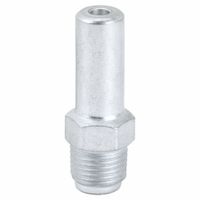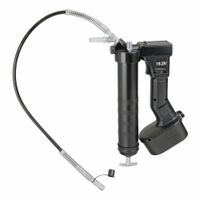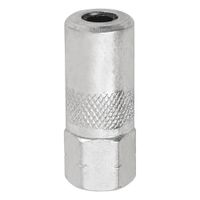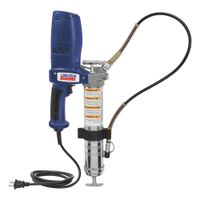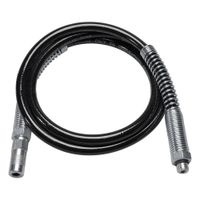Call +(254) 703 030 000 / 751 483 999 / 721 704 777
- Home
- Lubrication
- Grease Guns
.....Read More
Frequently Asked Questions
What is the best type of grease gun for automotive use?
For automotive use, several types of grease guns offer different advantages depending on the specific application. Manual grease guns, such as pistol grip or lever-style, are cost-effective and provide good control for occasional or light-duty tasks. They require manual pumping, which can be a workout for larger jobs. Pneumatic grease guns, powered by an air compressor, are excellent for high-volume greasing and reduce user fatigue, making them ideal for professional shops or frequent maintenance. Battery-powered (cordless) grease guns offer the convenience of portability and power, eliminating the need for an air compressor or power outlet. They are versatile for various automotive applications, from chassis lubrication to bearing maintenance. For precise applications, some grease guns offer adjustable pressure settings or digital readouts. The "best" type ultimately depends on the frequency of use, the volume of grease required, and budget considerations.
How do you load a grease gun?
Loading a grease gun can be a simple process, but it's important to do it correctly to ensure proper lubrication and avoid air pockets. There are generally three common methods for loading a grease gun: with a grease cartridge, with bulk grease, or using a filler pump.
The most common and cleanest method is using a grease cartridge. First, unscrew the barrel of the grease gun from the head. Pull the plunger rod all the way back and lock it in place. Remove the caps from both ends of a new grease cartridge and insert the cartridge into the barrel, open end first. Reattach the barrel to the head, then release the plunger rod. You may need to press the air bleeder valve on the head of the gun while pumping the handle a few times to purge any air and ensure a steady flow of grease.
Loading with bulk grease requires a bit more care to prevent air entrapment. Unscrew the barrel and pull back the plunger rod as before. Use a spatula or putty knife to scoop bulk grease into the open end of the barrel. As you fill, try to push the grease towards the bottom of the barrel to minimize air pockets. Once filled, reattach the barrel and release the plunger rod. Again, use the air bleeder valve and pump the handle to remove any trapped air.
For high-volume users, a filler pump can be used. This method typically involves a bulk grease container with a pump that directly fills the grease gun. To use this, connect the fitting on the end of the grease gun to the filler pump's nozzle. Operate the pump to fill the gun, then disconnect when full. This method is often the cleanest and most efficient for frequent users.
Regardless of the method, always ensure the grease gun is clean before loading to prevent contamination. Regularly bleeding air from the system is crucial for efficient greasing and to avoid air locks, which can prevent grease from flowing.
What is the difference between manual, battery-powered, and pneumatic grease guns?
Manual, battery-powered, and pneumatic grease guns each offer distinct advantages and disadvantages depending on the application.
Manual grease guns are the most basic and economical. They require the user to pump a lever or squeeze a pistol grip to dispense grease. These are suitable for light-duty applications, occasional greasing, or when precise control over grease volume is needed. Their main drawbacks are the physical effort required, which can lead to fatigue in larger jobs, and slower dispensing speeds.
Battery-powered grease guns, also known as cordless grease guns, use a rechargeable battery to power a motor that dispenses grease. They offer significantly higher speed and less physical effort than manual guns, making them ideal for medium to heavy-duty applications or when working in remote locations without access to compressed air. However, they are generally heavier and more expensive than manual guns, and battery life can be a limiting factor.
Pneumatic grease guns utilize compressed air to dispense grease. These are the most powerful and fastest type of grease gun, capable of delivering high volumes of grease under continuous pressure. They are best suited for industrial settings, heavy machinery, or applications requiring frequent and extensive greasing. The main disadvantage is the need for an air compressor and hose, which limits portability and can be noisy.
Choosing the right type depends on factors like the frequency of use, the volume of grease needed, accessibility to power sources, and budget.
How do you maintain a grease gun?
Please provide the complete question you would like me to answer.
What are the common problems with grease guns and how to fix them?
Common grease gun problems often stem from user error or improper maintenance. One frequent issue is an air lock, which prevents grease from flowing. This can be fixed by bleeding the air out of the gun, usually by loosening the filler cap or a bleeder valve. Another common problem is a clogged nozzle or fitting, which can be resolved by cleaning or replacing the affected part. Sometimes, the grease gun might leak, indicating worn-out seals or a damaged hose. Replacing these components can usually fix the leak. If the gun isn't dispensing grease, it could be due to a faulty plunger, an empty canister, or an incorrect grease viscosity for the temperature. Checking the grease level, ensuring the correct grease type, and inspecting the plunger can help diagnose and fix this issue. Regular cleaning, proper storage, and using the correct grease type are key to preventing most grease gun problems.
How do you choose the right grease for your grease gun?
Choosing the right grease for your grease gun involves considering several factors to ensure optimal performance and longevity of your equipment. First, understand the type of equipment you are lubricating. Different machines and components have specific lubrication requirements based on their operating conditions, such as speed, load, temperature, and environment.
Next, identify the base oil and thickener type of the grease. Common base oils include mineral and synthetic, each offering different performance characteristics. Thickeners, such as lithium, calcium, or aluminum complex, determine the grease's consistency and how well it resists breakdown under various conditions.
Consider the National Lubricating Grease Institute (NLGI) consistency grade. This scale indicates the grease's hardness or softness, ranging from 000 (very fluid) to 6 (very hard). The appropriate grade depends on the application, with softer greases often used for lower speeds and harder greases for heavier loads.
Also, look for additives that enhance the grease's properties. These can include extreme pressure (EP) additives for high-load applications, anti-wear (AW) additives to reduce friction, rust and oxidation inhibitors for protection against corrosion, and tackifiers for improved adhesion.
Finally, always refer to the equipment manufacturer's recommendations. They often specify the exact type of grease or the required properties for proper lubrication, ensuring compatibility and optimal performance.
What is a zerk fitting and how does it work with a grease gun?
A zerk fitting, also known as a grease nipple or grease zerk, is a small, typically conical, metal fitting with a spring-loaded ball valve. It is installed on machinery to allow for easy lubrication of bearings, joints, and other moving parts. The fitting is designed to accept grease from a grease gun.
When a grease gun is connected to a zerk fitting, the nozzle of the gun presses against the fitting, opening the ball valve. This creates a seal and allows pressurized grease to be injected directly into the component. The spring-loaded ball valve then closes when the grease gun is removed, preventing dirt and debris from entering the lubricated area and holding the grease in place. Zerk fittings come in various sizes and angles to accommodate different applications and access points. Regular lubrication via zerk fittings helps reduce friction, prevent wear, and extend the lifespan of mechanical components.
How do you prevent air pockets in a grease gun?
To prevent air pockets in a grease gun, there are several methods you can use:1. **Bleeding the Gun:** This is the most common method. If your grease gun has a bleeder valve (a small screw or button), open it while pumping the handle. This allows trapped air to escape until grease flows smoothly. Once grease starts coming out, close the valve.
2. **Loading Cartridges Correctly:** When inserting a new grease cartridge, ensure it's pushed firmly all the way into the barrel. Some guns require you to pull a plunger rod back to create a vacuum before inserting the cartridge, then release the rod.
3. **Priming the Gun:** If you're using bulk grease, fill the gun slowly and evenly to minimize air entrapment. After filling, you might need to pump the handle a few times while holding the nozzle against a surface to build pressure and expel air.
4. **Checking for Leaks:** Loose connections or damaged seals can allow air to be drawn into the system. Regularly inspect the gun's components for any signs of wear or leaks.
5. **Storing Properly:** Store the grease gun in a way that minimizes the chance of air entering the system, such as horizontally or with the nozzle pointed downwards.By following these steps, you can ensure a consistent flow of grease and avoid the frustration of air pockets.
What are the safety precautions when using a grease gun?
When using a grease gun, always wear appropriate personal protective equipment (PPE), including safety glasses or goggles to protect your eyes from splashes, and gloves to prevent skin contact with grease. Ensure the grease gun is in good working condition, free from leaks, and that the nozzle is securely attached. Never point the grease gun at yourself or others, as the pressurized grease can cause serious injury. Before starting, clean the grease fitting to prevent contaminants from entering the lubrication point. When applying grease, avoid over-greasing, which can lead to excessive pressure buildup and potential damage to seals or bearings. Always release pressure from the grease gun before storing it or changing accessories. Store grease guns and lubricants in a clean, dry area, away from heat sources and open flames. If using an air-powered grease gun, ensure the air pressure does not exceed the manufacturer's recommended limit. In case of a blockage, do not attempt to clear it by increasing pressure; instead, disassemble and clean the gun. Finally, always refer to the equipment manufacturer's manual for specific instructions and safety guidelines related to the grease gun and the machinery being lubricated.
How do you clean a grease gun after use?
To clean a grease gun after use, especially when switching grease types or if the gun is gummed up, follow these steps:1. **Empty the Grease:** If using a cartridge, remove it. For bulk-filled guns, try to pump out as much old grease as possible.
2. **Disassemble (if necessary):** For a thorough cleaning, you might need to disassemble the barrel, follower, and pump head. Consult your grease gun's manual for specific disassembly instructions.
3. **Clean the Barrel:** Use a rag to wipe out the inside of the barrel. For stubborn residue, you can use a solvent like mineral spirits or a dedicated grease gun cleaner. Ensure good ventilation if using solvents.
4. **Clean the Pump Mechanism:** This is the most critical part. Use a stiff brush, rags, and solvent to clean the plunger, check valves, and any other components of the pump head. Ensure no old grease or debris remains that could impede flow or contaminate new grease.
5. **Clean the Nozzle/Hose:** Wipe down the outside of the nozzle and hose. If the nozzle is clogged, you might need to soak it in solvent or use a small wire to clear the blockage.
6. **Rinse and Dry:** After using solvent, ensure all components are thoroughly rinsed and dried to prevent contamination of new grease.
7. **Reassemble:** Put the grease gun back together according to the manufacturer's instructions.
8. **Lubricate (Optional but recommended):** Before loading new grease, you can apply a thin layer of the new grease or a compatible lubricant to the internal moving parts to ensure smooth operation.Regular cleaning helps maintain the grease gun's efficiency and prevents cross-contamination of different grease types.
